Management policy
artience group 's Brand Promise and Philosophy System
Management plan
artience2027/2030 “GROWTH”
artience group has set a management plan artience2027/2030 "GROWTH" with the goal of 2030. Throughout the period from January 2024 to December 2029, we will work to transform our business portfolio, maximize capital efficiency and cash flow, build a corporate foundation, and engage in sustainability management, thereby contributing to the realization of a society where people can live fulfilling lives.
Medium-Term Management Plan artience2027
Disclosure on February 19, 2024 (partially revised on February 20, 2025)
- Disclosure Materials
- Background of Formulation
- Medium-Term Management Plan artience2027
- artience2027 Basic Policy
- Capital policies
1. Disclosure Materials
Disclosure on February 19, 2024
Formulation of the New Medium-Term Management Plan "artience 2027"(PDF: 626KB)
Medium-Term Management Plan artience2027/2030(PDF:1,611KB)
Notice Regarding Development of New Medium-Term Management Plan artience 2027(PDF:598KB)
Medium-Term Management Plan artience 2027/2030(PDF:1,611KB)
Disclosure on February 20, 2025
Partial Revision of Capital Policy in Medium-Term Management Plan "artience 2027"(PDF: 1,319KB)
Financial Results Briefing for the Fiscal Year Ending December 2024(PDF: 2,943KB)
Video of financial results briefing for the fiscal year ending December 2024
Notice of Partial Revision of Capital Policy under Medium-term Management Plan artience 2027(PDF:595KB)
Presentation data of FY2024 Results Briefing(PDF:1,777KB)
2. Background of Formulation
Under the previous medium-term management plan, the Company made some progress in activities for future growth, including the launch of a business of carbon nanotube (CNT) dispersions for lithium-ion batteries (LiB), amid significant changes in circumstances such as the COVID-19 pandemic, rapid price hikes of raw materials and the prolongation of the Ukraine conflict. Meanwhile, some shortfalls in financial results and in the business foundation remained, such as the earnings capacity of existing businesses and cash flows.
Under these conditions, the Company changed its name to artience Co., Ltd. and developed a new medium-term management plan with a view to offering value that resonates with the senses in response to changes in value sought by society and to become a company that helps build enriched and sustainable societies.
To place the Group on a growth track and show its presence in the market, the Company will carry out reforms with a strong determination in the primary pursuit of GROWTH.
3. Medium-Term Management Plan artience 2027
The Plan sets a target of reaching a Group return on equity (ROE) of 10% or more by the fiscal year ending December 31, 2029. It also sets an interim ROE target of 8.0% or more in the fiscal year ending December 31, 2026. Numerical targets include a net sales target of 400 billion yen and operating profit target of 25 billion yen for the fiscal year ending December 31, 2026.
The Plan specifies three key management issues: business portfolio transformation, maximizing capital efficiency and cash flow, and establishment of corporate foundations and sustainability management practices.

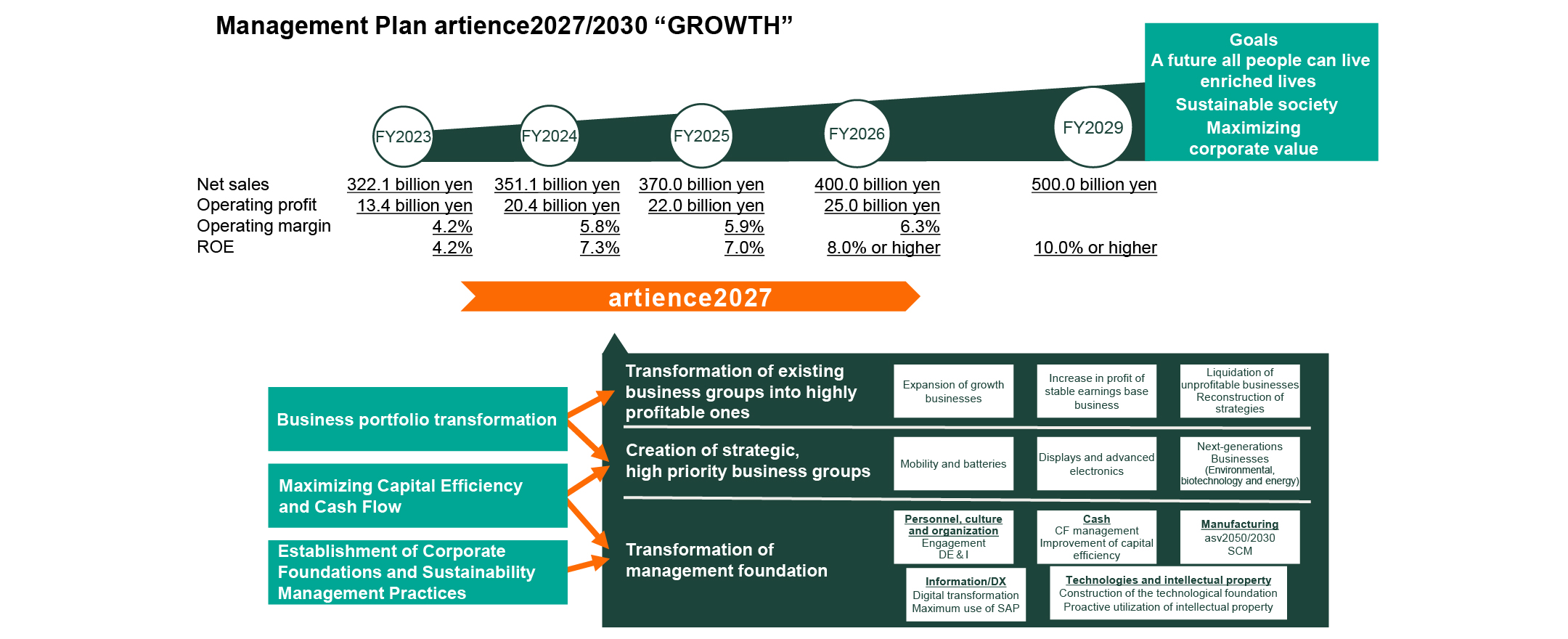
4. artience 2027 Policy
The Plan has three basic policies mentioned below. The Company aims to accomplish its business portfolio transformation by following both policies 1 and 2.
| Basic Policy 1 |
|
|---|---|
| Basic Policy 2 |
|
| Basic Policy 3 |
|
Basic Policy 1: Transforming of existing businesses groups into highly profitable ones
(FY2026 net sales of 330 billion yen, operating profit of 19 billion yen)
We will classify our existing businesses into growth business, stable earnings base business, and business of restructuring and rebuilding strategy, and aim to increase profitability by promoting reforms, including product and market portfolio transformations.
- Achieve high profitability through growth especially in the area of packaging, such as liquid inks, pressure sensitive adhesives and laminating adhesives.
- Capture growth in the global markets, with particular focus on the Asia (Southeast Asia and India).


- Only representative businesses are listed
- Total includes other and adjustments.
- Business of restructuring and rebuilding strategy include next-generation businesses.
Basic Policy 2: Creation of strategic priority businesses
(FY2026 net sales of 70 billion yen, operating profit of 6 billion yen)
We will strategically allocate the Group's resources in two areas (mobility and battery-related businesses and displays and advanced electronics-related businesses) to create new bases of earnings.

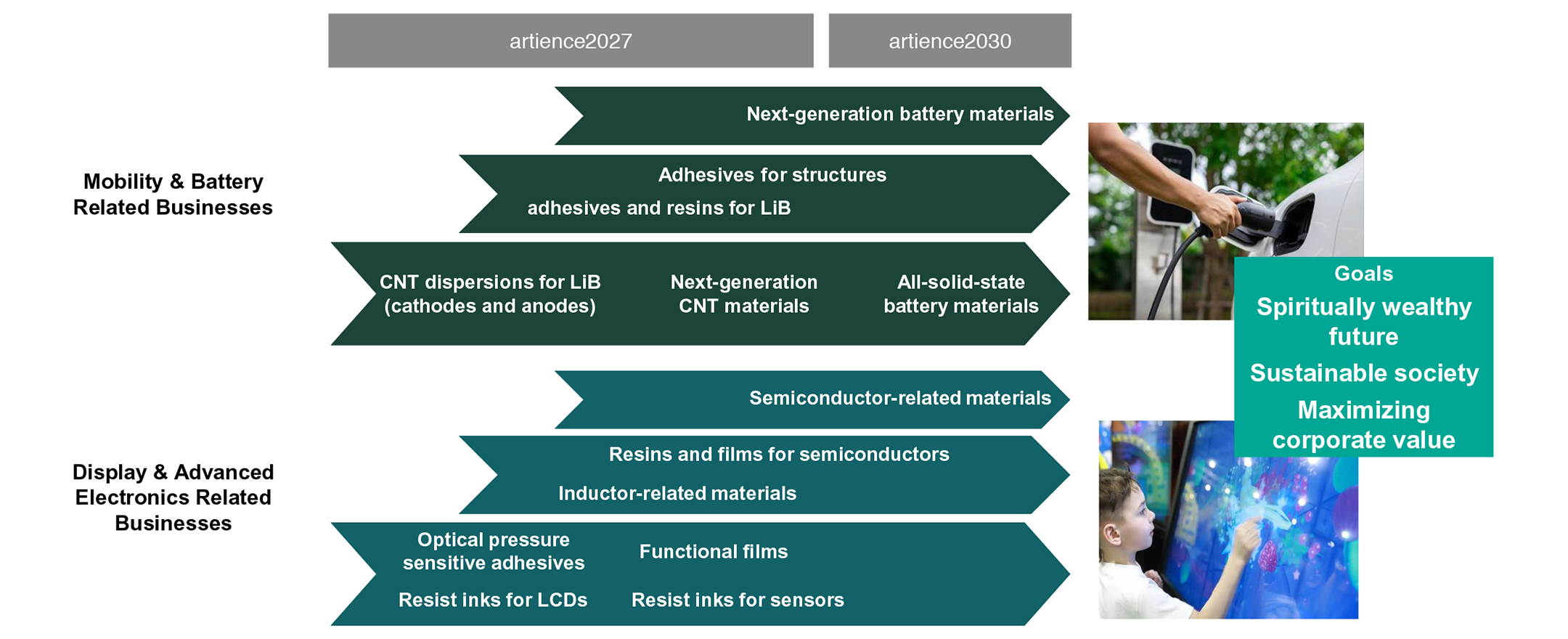
Business portfolio transformation with basic policy 1 & 2
- Expand business in global and other growth markets (overseas sales ratio: 53.7% in FY23 → 60% or more in FY26)
- Create a pillar of earnings in strategic, high priority business groups

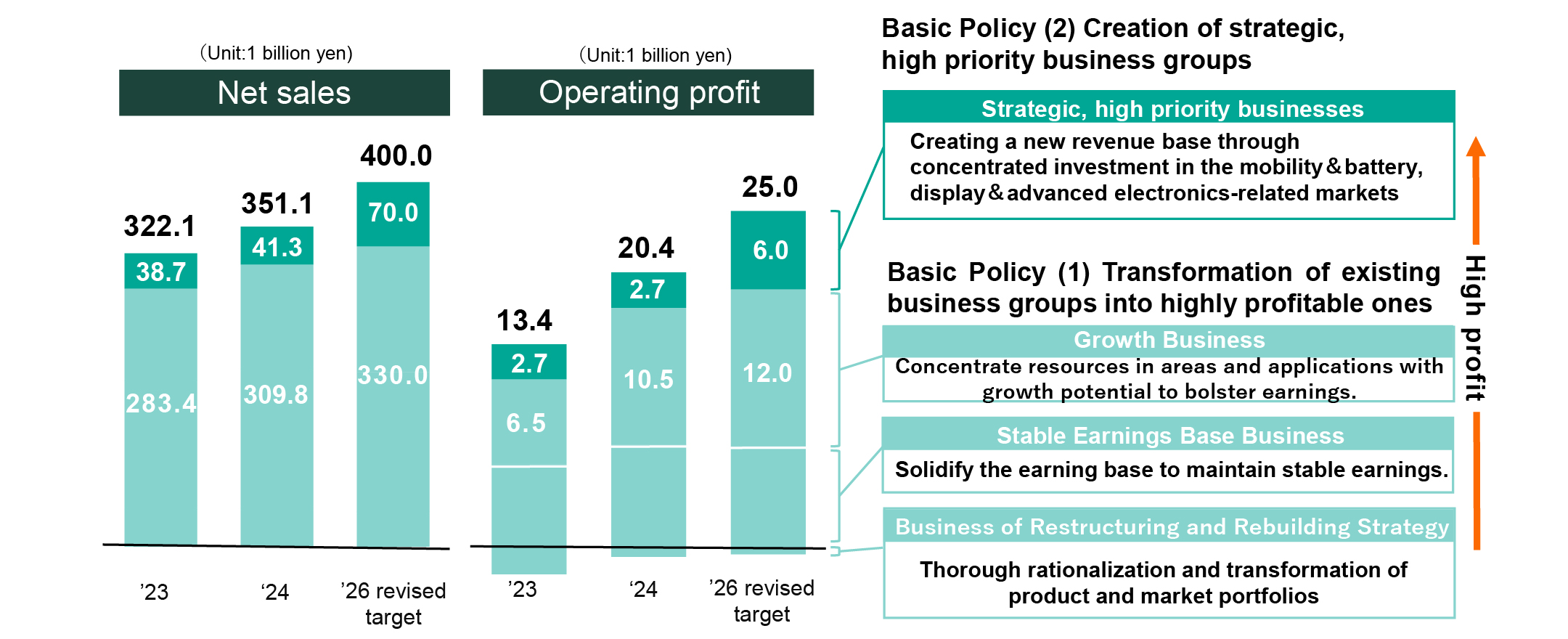
- Total includes other and adjustments.
Basic Policy 3: Reform of business foundation
The Company will review its conventional ways of working and carrying out its duties from scratch and will boldly introduce new ways to create an attractive organization and culture with vigor and discipline as well as sternness. We will put particular emphasis on human resources and culture and on cash since they are starting points of the transformation.
| E |
|
|---|---|
| S | Reforms of personnel, culture and organization
|
| G |
|
|
Information/DX |
|
|
Technology & intellectual property |
|

- Create an attractive organization and a culture with vigor and discipline as well as sternness.
- Increase productivity and create value with the use of digital technologies and AI.
- Meet social responsibility based on asv2050/2030.
- Construct an artience brand based on the new philosophy system.
5. Capital Policy
1.Action to implement management that is vonscious of cost of capital and stock price
With the perception that the Company’s cost of equity is around 7% in fiscal 2025, the Company will undertake a business portfolio transformation and approach management with an awareness of increasing capital efficiency, aiming to achieve profit that exceeds the cost of equity. In addition, the Company will target an ROE of 8.0% or more in the fiscal year ending December 31, 2026 and an ROE of 10.0% or more in the fiscal year ending December 31, 2029 in a bid to increase the price book-value ratio (PBR).
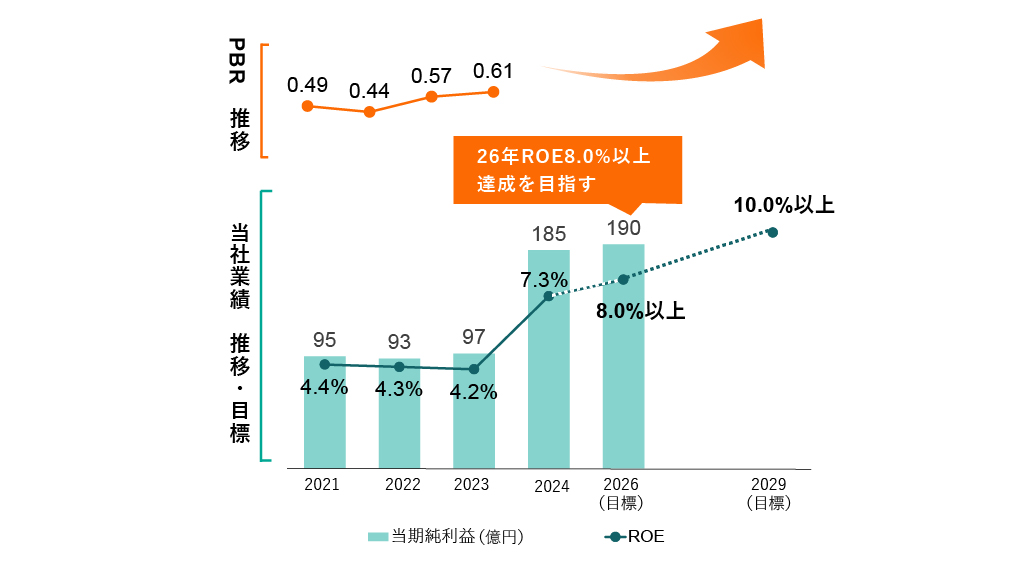
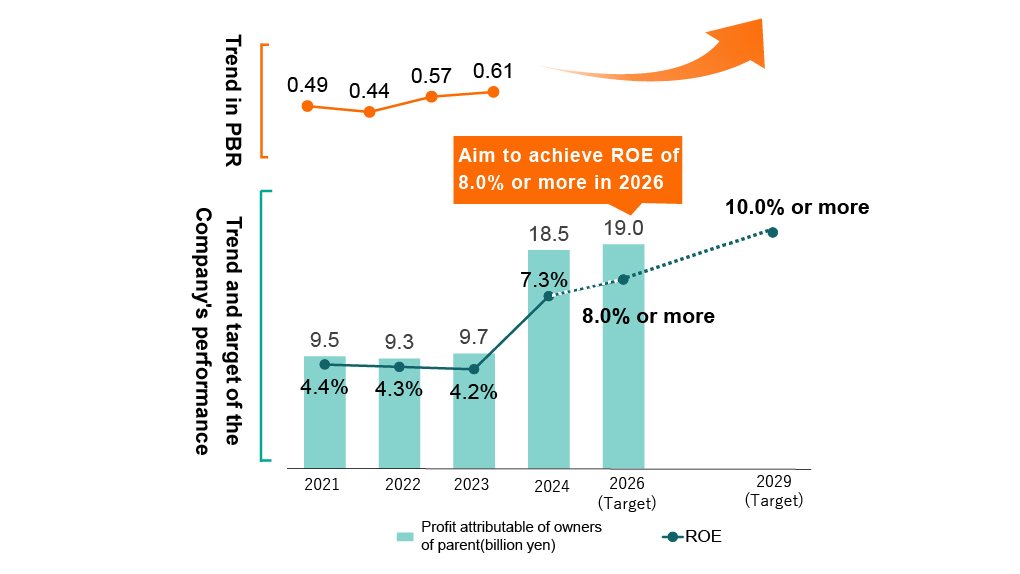
|
Business portfolio transformation |
|
|---|---|
|
Increase capital efficiency |
|
|
Capital policies |
|
|
Efforts to lower capital costs |
|
- With an upper limit of 4,500,000 shares or 10.0 billion yen,Acquisition period: August 13, 2024 to August 12, 2025
Dialogue with shareholders and investors
2. Investment plan and cash allocations
With a view towards medium- and long-term growth based on the basic policies, the Company is planning to positively invest around 60 billion yen in total, exceeding the amount of investment of 46.8 billion yen under the previous medium-term management plan. The total amount consists of around 30 billion yen to be invested mainly in existing businesses and another 20 billion yen or so in the business of CNT dispersions for LiB.
While prioritizing these investments for the future, the Company will also positively consider paying shareholder returns.

Allocation of capital investment plan
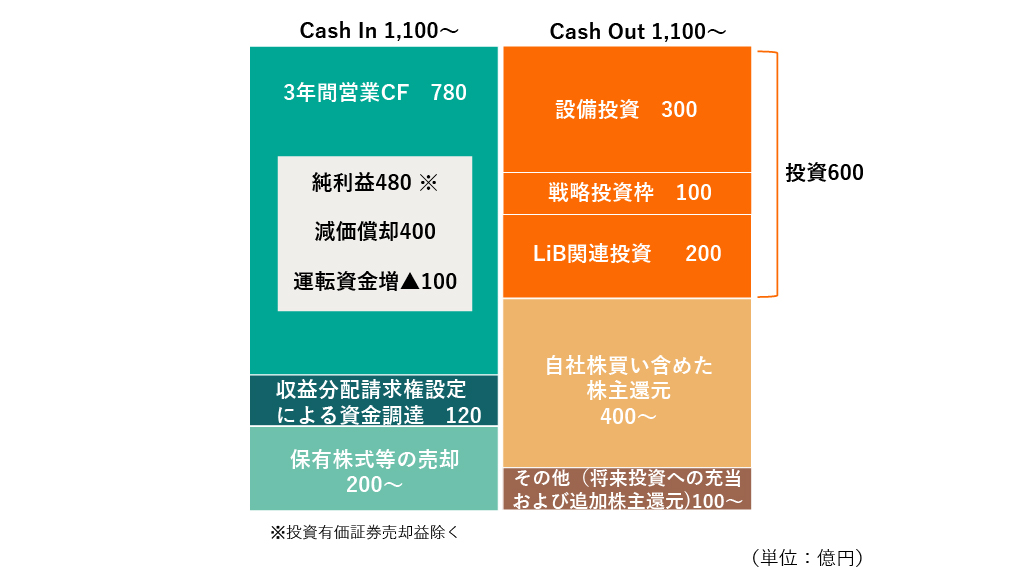
Cash allocation

Allocation of capital investment plan
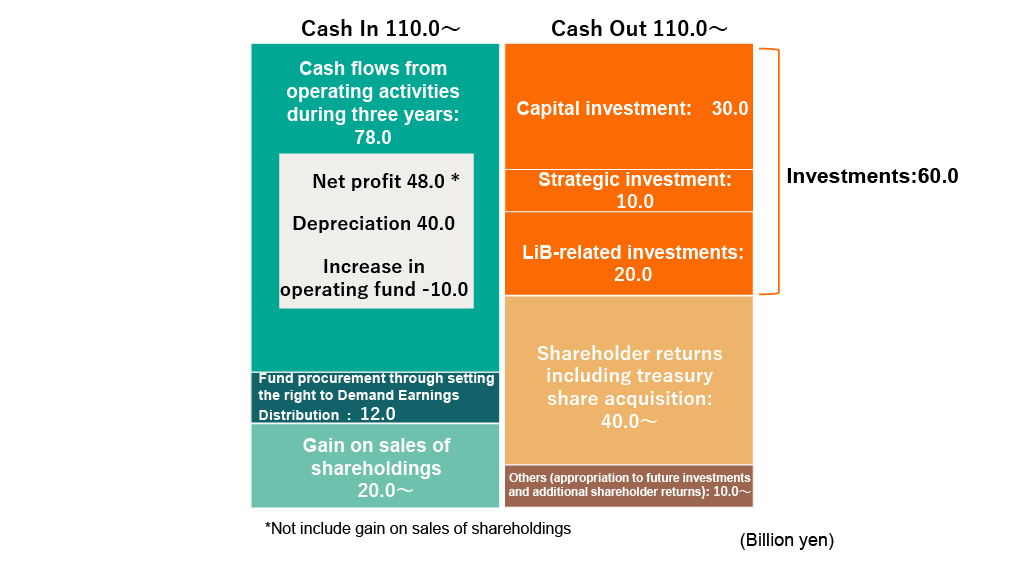
Cash allocation
3. Shareholder return policy
* On August 9th 2024, announced annual dividend, including interim dividend, will be 100 yen (+10 yen than previous fiscal year)
* On August 9th 2024 ,announced 4.5million shares(maximum)or 10 billion yen(maximum) Treasury Share Acquisition . Period: Aug. 13, 2024-Aug. 12, 2025
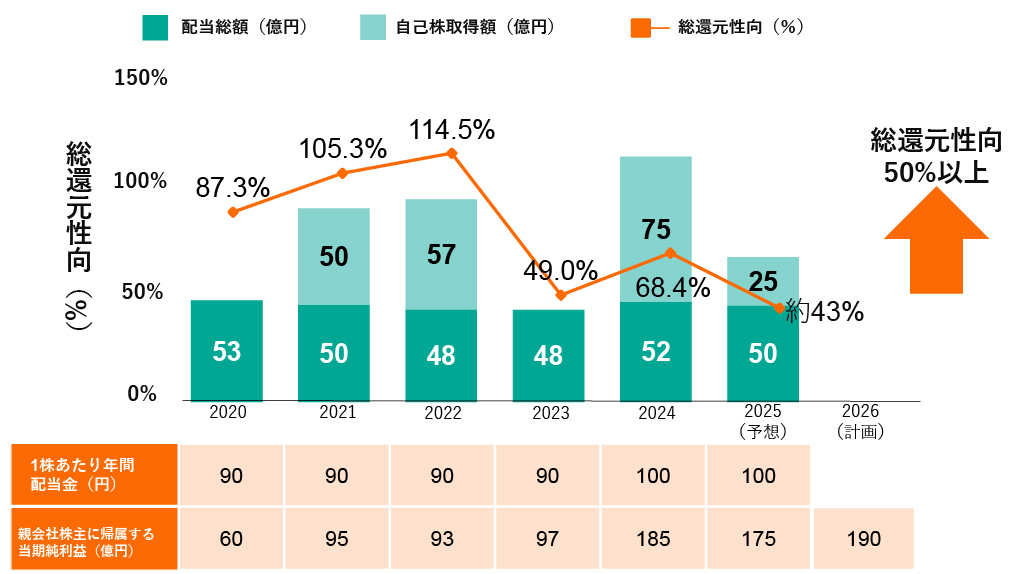
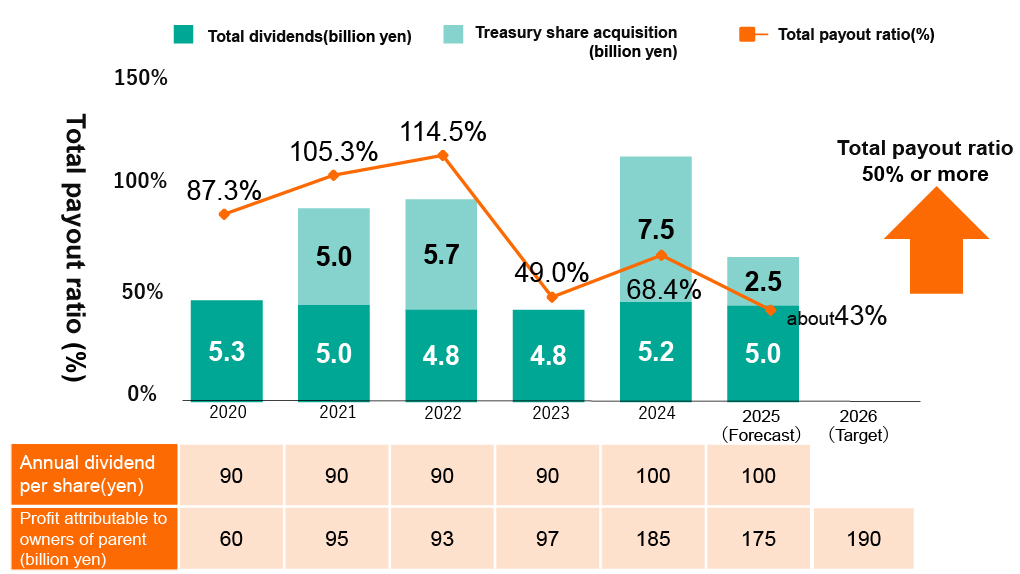
Value Creation Model
The Group works to provide value through products and services created through its business activities, with the aim of sustainable growth of the Group and society. We leverage unique core technologies developed over the course of many years, a culture of open innovation geared toward co-creation, and global business expansion, with more than half of the Group’s net sales and operating profits coming from overseas operations. By building a business model that makes effective use of these strengths of the Group, we are creating value that resonates with the senses.
(From Integrated Report 2025)

Sustainability Vision
asv2050/2030
(Established in January 2022 and revised in February 2025)
In January 2022, artience group established the Sustainability Vision asv2050/ as a practical long-term goal of the Group's CSR/sustainability activities in order to respond to recent global trends related to climate change, carbon neutrality, and SDGs initiatives, as well as the social situation in which demands directed at companies are becoming more active. 2030 was established (renamed from TSV2050/2030 in January 2024).
The Sustainability Vision ASV2050/2030 consists of two goals: ASV2050, which sets 2050 as the target year, and ASV2030, which sets 2030 as an interim target year.
ASV2050 is a basic vision for promoting various sustainability activities centered on the achievement of carbon neutrality by 2050, which the Group declared in its previous medium-term management plan (2021~2023). On the other hand, ASV2030 is a milestone on the time axis of ASV2050 and an interim goal to promote the contribution of the corporate group to the achievement of the SDGs (Sustainable Development Goals) proposed by the United Nations with 2030 as the target year.
ASV2050/2030, which consists of these two goals, consists of the three pillars of "providing products and services that realize a sustainable society," "reducing the environmental impact of manufacturing," and "building a trusted corporate foundation," which are the direction of the Group's value offering, and will serve as the basis for all of the Group's CSR, sustainability, and ESG initiatives.
ASV2050/2030 before the revision is introduced on page 6 of the Sustainability Data Book 2024(PDF: 715 KB).
1. Providing products and services that realize a sustainable society
| asv2030 | asv2050 | Vision for 2050 |
|---|---|---|
|
|
All products and services we provide contribute to sustainability |
|
|
1-1. Make all products sustainability-contributing products
artience group has been working to improve the environmental friendliness of its products from an early stage, and has been releasing a variety of environmentally-friendly products since the 1990s. In recent years, the Group's product development has focused not only on the "environmental value" of the coexistence of the environment and society, but also on the aspects of people's comfort, health and welfare, safety and security, and as a result, we have launched a diverse range of products that can contribute to the improvement of the sustainability of society.
Therefore, in line with the formulation of ASV2050/2030, we have added the standard of "products with life value" to the existing standards for environmentally-friendly products, and redefined them as "artience group sustainability products." This expansion of the definition will add a range of products with various functions and features of life value, such as digital-related materials for IoT and high-speed communications, sensor materials (safety of autonomous driving, comfort of the living environment), and bio- and medical-related materials (medical, drug discovery, and healthcare).
The Group has set a quantitative target of increasing the ratio of these sustainability-contributing products to total sales of the Group to 100% by 2050, both in Japan and overseas, and as an intermediate step, achieving the ratio of 80% by 2030.
| Value provided | Direction | keyword | Examples of Initiatives and Products |
|---|---|---|---|
| Environmental value Realization of a society in harmony with the environment | Decarbonization | Clean Energy, New Energy Energy Reduction, EV Transportation | Proposal and advanced development of materials and technologies that contribute to the acceleration of EVs (LiB materials, thermal control materials) |
| Contributes to the reduction of CO2 emissions during use (UV/EB conversion) Development of new environmentally-friendly power generation systems and proposals for materials | |||
| Resource Recycling | Reduce reuse recycle Alternative materials | Reduction and replacement of the ratio of petrochemical raw materials (biomass, water-based) | |
| Simplification of product composition, replacement with paper (biodegradable materials, functional coatings) | |||
| Development of materials and systems that support plastic circulation (materials and systems that support horizontal recycling) | |||
| Symbiosis with nature | Environmental Harmony, Symbiosis, and Purification Reduction of Environmentally Hazardous Substances | Heat shield paint, heat preservation Soil improvement, wastewater purification, and utilization of renewable energy | |
| carbon recycling | Taking on the challenge of CCUS (CO2 capture, utilization, and storage) technology and utilization of CO2-derived raw materials | ||
| Life value Realization of a comfortable, healthy, and safe society | Medical/Healthcare field | Prevention/diagnosis | Development of diagnostic materials and systems that lead to early detection and prevention of diseases and reduction of morbidity risk |
| treatment | Development of pharmaceuticals and medical materials that contribute to advanced treatment and self-care | ||
| safe and secure | Providing safe and secure products that have no effect on living organisms (products that do not contain harmful substances) | ||
| Communication/electronics/digital area | High speed/large capacity communication | Development of next-generation materials that support photonics, high-speed large-capacity transmission, and high-speed calculations | |
| advanced sensing | Providing key materials to realize a sensor society and a society connected by IoT | ||
| big data | Taking on the challenge of technology that leads to the realization of a convenient society through the use of data | ||
1-2. Contributing to decarbonization of the entire value chain
The other goal, "Contributing to the decarbonization of the entire value chain," is a commitment to our client companies and the consumer base beyond them, which are aiming for low-carbonization, decarbonization, and CO2 emission reduction, as well as artience group. Looking at the products sold by the Group as a BtoB material manufacturer throughout the value chain, the Group is positioned upstream of the supply chain from the customer's point of view, and CO2 emissions from the Group's production and corporate activities have a significant impact on CO2 emissions for customers, especially CO2 emissions from raw materials (Scope 3 Category 1).
In order to support and cooperate with our customers in their efforts to achieve low-carbonization, decarbonization, and carbon neutrality as a supplier, the Group will promote the reduction of CO2 emissions from its products (selection of low-carbon raw materials, low-carbon energy used during production, etc.). In addition, we will promote decarbonization throughout the value chain by expanding our product lineup that can contribute to the reduction of CO2 emissions from the perspective of the product life cycle, such as more efficient transportation, lower carbonization, reduction of energy and fuel during product manufacturing on the customer side, energy conservation during use on the consumer side, and easy recyclability at the time of disposal.
2. Reducing the environmental impact of manufacturing
| asv2030 | asv2050 | Vision for 2050 |
|---|---|---|
|
|
The environmental impact of manufacturing is minimized. |
|
|
|
|
|
|
|
|
2-1. Achieve carbon neutrality in production activities and minimize GHG emissions in corporate activities as a whole
Since the launch of the CO2 Reduction Project in fiscal 2010, artience group has been working to reduce CO2 emissions at its production sites in Japan and overseas. In fiscal 2018, we formulated new medium- to long-term environmental targets, which were to reduce domestic CO2 emissions by 26% by fiscal 2030 (compared to fiscal 2013) and to set interim targets for the end of the medium-term management plan every three years through scientific backcasting.
Through all-round reforms to achieve the target, domestic CO2 emissions in fiscal 2020 were 76,843 t-CO2, far below the target of 78,600 t-CO2 for fiscal 2026. Therefore, in FY2021, we declared that we would achieve carbon neutrality by FY2050 as a more stringent target, which became the central goal when formulating ASV2050/2030.
In the revision of ASV 2050/2030 for FY2025, the scope of targets has been expanded from limited to production activities to all corporate activities, including non-production sites.
In ASV2030, which is a milestone, we have set a 35% reduction in CO2 emissions in Japan to 50,000 t-CO2 compared to FY2020 (a 50% reduction compared to FY2013). To achieve this, we will take various measures in three aspects: reducing energy consumption, low-carbon energy, and low-carbon electricity. In addition, carbon offsets through emissions trading are also available as one of the cards, and we are also looking at negative emissions (initiatives to reduce negative emissions) for the future.
On the other hand, we have set a 35% reduction in CO2 emissions from our overseas bases, which we are aiming to grow and expand our business in the future, to 95,000 t-CO2, a * reduction compared to the BAU in FY2030. Overseas, the ratio of indirect emissions is larger than in Japan (the energy mix is shifting to electricity rather than fuel), so we will promote measures centered on low-carbon electricity.
This target is a 26% reduction in Scope 1+2 emissions (compared to FY2020) based on the GHG Protocol (an international standard for calculating and reporting greenhouse gases by companies) and unifying both domestic and overseas on a global basis.
- BAU ratio: Comparison with emissions when no measures are taken to prevent the increase in CO2 emissions due to business growth (Business as usual)
| Direction of measures | Example of measures |
|---|---|
| Reduce energy usage |
|
| Low carbon energy |
|
| Low-carbon electricity |
|
| carbon offset |
|
| negative emissions |
|


2-2. Achieving sustainable water use in production activities
artience group uses a large amount of fresh water for applications such as process water (water used for chemical reactions in water systems, cleaning of products, etc.), cooling water, and washing water. Water resources are one of the Group's important natural capitals, and we recognize that improving the sustainability of water use is an important issue. In fiscal 2020, approximately 73% of the water intake was from land-based freshwater systems such as groundwater or industrial water (water taken from rivers and lakes). We have been striving to reduce water consumption and purify wastewater through thorough circulation and cooling, reuse and recycling after use, but in the future, we will further reduce overall water consumption through the development of production processes that do not require water and the introduction of new irrigation technologies, and work on water use based on the premise of environmental conservation and biodiversity conservation.
2-3. Minimize waste generation and maximize recycling
Since the 1970s, when the Waste Disposal and Public Cleansing Act (Waste Disposal and Public Cleansing Act) was enacted in Japan, artience group has been promoting the reduction of waste generation and recycling in its business activities, and has been striving to reduce the amount of waste generated and achieve zero emission * at all business sites.
In fiscal 2020, the * amount of waste generated externally in Japan was 10,822 tons, of which the top three types accounted for about 80% of the total amount: 55% of waste oil, 12% of waste plastics, and 10% of wastewater. By focusing on these and promoting measures, we will effectively reduce the amount of waste emitted externally.
Breakdown of waste (domestic 2020)

As long as the Group is a chemical manufacturing company and continues to expand its production activities, the generation of waste is inevitable. Therefore, we aim to minimize the amount of waste generated by developing production processes that are less likely to generate waste, examining waste disposal methods, promoting resource recycling such as reduce, reuse, and recycling at the site, and sharing know-how on waste reduction globally. In the FY2025 revision, we will horizontally expand the zero-emission activities that we have achieved in Japan overseas with the aim of achieving zero emissions throughout the Group. In addition, in terms of resource recycling, we will not limit ourselves to the Group, but will also promote the reduction of the amount of raw materials and auxiliary materials used (resource conservation) through production process reforms and resource recycling through co-creation with partner companies.
- Zero emissions: An initiative proposed by the United Nations University to reduce waste to zero as much as possible through waste recycling. The Group defines the ratio of final disposal to waste generated (final disposal rate) as 1% or less. In fiscal 2023, the final disposal rate of waste generated in Japan was 0.15%, and we achieved zero emissions at all business sites.
- External Waste Discharge: The amount of waste sold as valuable and the amount of waste generated at the site that was released without being recycled on the site premises or moved outside the business site to be disposed of by a disposal company. Since it includes the amount of resource recycling outside the Group, it is not suitable as an index for resource recycling, and it was changed in the FY2025 revision.
2-4. Becoming a chemical manufacturer that does not emit hazardous chemical substances in its production activities
Since the Group is a chemical manufacturing company, we have been working to manage * hazardous chemical substances in our production activities and reduce their emissions. In fiscal 2020, we emitted 68.2 tons of chemical substances, but we will reduce emissions of hazardous chemical substances by 30% in fiscal 2030 compared to fiscal 2020 by thoroughly preventing leakage and direct discharge and promoting the optimization of the cost performance of wastewater treatment facilities.
- Hazardous chemicals: Generally refers to chemicals that are harmful to the human body and ecosystems. The Group targets substances designated as Class 1 designated chemical substances under the PRTR system of the Act on the Identification and Management of Chemical Substances (Chemical Substances Control Act) and substances designated by the Japan Chemical Industry Association.
3. Building a trusted corporate foundation
| asv2030 | asv2050 | Vision for 2050 |
|---|---|---|
|
|
We are a company that can contribute to improving the sustainability of society. |
|
||
|
||
|
||
|
As a supporter of all industries and markets, the ARTIENCE Group promotes corporate activities aimed at improving the sustainability of people's lives, the global environment, and all life that lives on them. In order to continue to be such a corporate group, we have constantly reformed our corporate governance and strived to improve our sustainability as a company.
ASV2050/2030 aims to "continuously reform and transform supply chains, human rights and diversity, human resource management, connections with local nature and communities, and governance from a sustainability perspective" over the long term until 2050, with "building a trusted corporate foundation" as a pillar. In addition, as interim goals by FY2030, we will "realize responsible procurement of raw materials that take into account human rights, labor, and the environment," "realize a work environment that respects human rights and diversity," "improve employee engagement by promoting human resource development that leads to growth and a work environment where employees can work safely and securely," "build governance that meets the expectations of stakeholders through constant reforms," and " Achieve value co-creation through partnership building and coexistence with local communities and nature," and we are promoting short- and medium-term measures for each of them.
| asv2030 | Example of measures |
|---|---|
| Responsible procurement of raw materials in consideration of human rights, labor, and the environment |
|
| Creating a work environment that respects human rights and diversity |
|
| Promote human resource development that leads to growth and a safe and secure work environment, and improve employee engagement. |
|
| Build governance that meets stakeholder expectations through continuous reform |
|
| Achieving value co-creation through partnership building and coexistence with local communities and nature |
|
